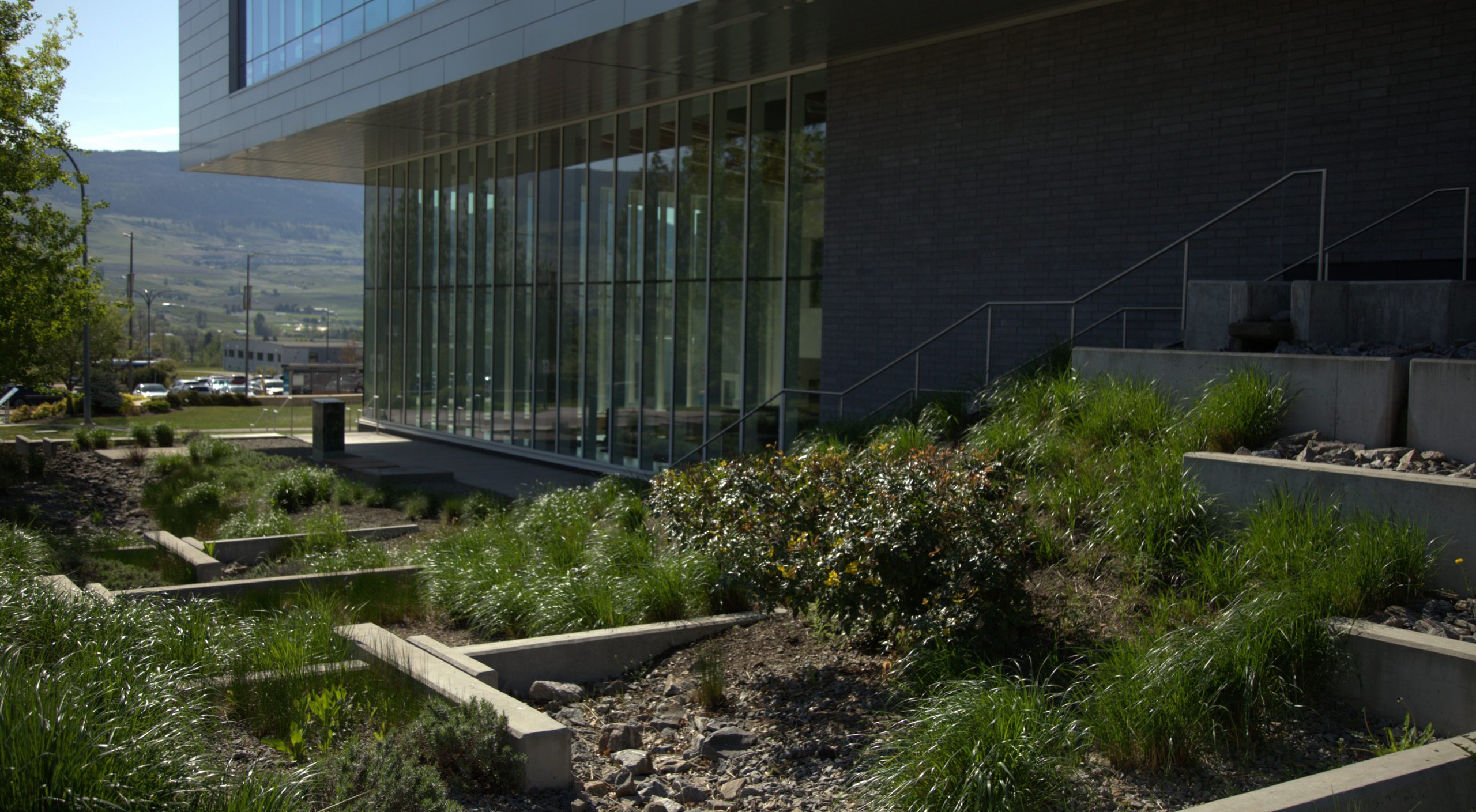Integrated Rainwater Management Plan

Sustainable rainwater solutions for a climate-resilient campus.
UBC Okanagan’s Integrated Rainwater Management Plan (IRMP) provides a comprehensive strategy to manage rainwater sustainably across campus. It supports long-term campus growth while preserving natural hydrological processes, enhancing ecological resilience and addressing climate adaptation. The IRMP also plays a critical role in mitigating flood risk and protecting campus infrastructure.
Building project requirements
The IRMP’s recommendations should be applied to the design and construction of all new capital and civil projects, substantive additions/renovations and applicable cyclical maintenance and renewal work. Implementation should be supported by UBC’s investments in the public realm and capital projects at the building scale, such as:
- New capital and civil projects: Ensuring that all new developments incorporate sustainable rainwater management practices.
- Substantive additions or renovations: Updating existing structures to align with current rainwater management standards.
- Cyclical maintenance and renewal work: Integrating IRMP guidelines into routine maintenance activities.
Project teams are advised to consult Part 1 of the IRMP for detailed information on minimum volumes and rates of water to be managed at each new development site.
Key goals
The plan sets minimum rainwater retention targets informed by climate modelling, with the goal of achieving 100 per cent diversion of rainwater from municipal systems—meeting the City of Kelowna’s bylaw requirements.
- Rainwater diversion: Achieve 100 per cent diversion from municipal systems through on-site rainwater retention.
- Green infrastructure: Integrate low-impact development (LID) strategies such as rain gardens, bioswales and infiltration planters.
- Ecological protection: Protect sensitive habitats and species, including the Great Basin Spadefoot Toad and Western Painted Turtle.
- Climate adaptation: Use climate modelling to guide infrastructure design that is resilient to future conditions.
Official documents and resources
- Part 1: Integrated Rainwater Management Plan
- Part 2: Maintenance Manual
- Part 3: Interim Reports
- Part 4: Geotechnical Investigations and Soils Domain Map
- Part 5: Public Consultation Summary Reports
Integration with other plans
Implementation
Implementation of the IRMP ensures that campus development aligns with the goal of 100 per cent on-site rainwater management. The following initiatives highlight how the IRMP is being put into practice across campus.
Serves as a multifunctional feature for stormwater retention, recreation and habitat. Find out more lower on the page.
Capture and slowly release stormwater, reducing peak flow rates.
Temporarily store excess stormwater during heavy rainfall events.
Installed on buildings like Purcell Residences and Reichwald Health Sciences Centre to manage runoff.
Allow water to percolate directly into the soil, promoting groundwater recharge.
Temporarily hold water before directing it to appropriate drainage systems.
Shallow, vegetated channels that slow down runoff and facilitate infiltration.
UBCO’s Rainwater Management Approach
UBC Okanagan employs a low-impact development strategy to manage rainwater sustainably. This approach integrates green infrastructure solutions that mimic natural hydrological processes, aiming to:
- Filter and store rainwater close to where it falls.
- Infiltrate water into the ground to recharge aquifers.
- Utilize rainfall for non-potable purposes, reducing demand on municipal systems.
The pond
The retention pond at UBC Okanagan serves as a vital component of the IRMP. Beyond its functional role in managing stormwater, the pond offers ecological, social and educational benefits to the campus community.
- Habitat support: The pond provides a habitat for various species, contributing to campus biodiversity.
- Educational resource: It serves as a living laboratory for students and faculty engaged in environmental studies.
- Community engagement: The pond is a valued natural space for relaxation and recreation, fostering a connection between the campus community and the environment.
To assess the impact of future campus development on the pond, rainfall modelling exercises were conducted, evaluating four land use scenarios:
- Existing conditions
- Future development without site controls
- Future development with site controls at mandatory sites
- Future development with site controls at all sites
Key findings include:
- Runoff reduction: Implementing site controls across all projects can significantly reduce the volume of runoff entering the pond.
- Water level implications: While reducing high flows mitigates flood risks, excessive reduction of low flows during dry periods may adversely affect pond health.
Recognizing the pond’s importance, a monitoring program is integral to the IRMP’s implementation. Continuous assessment ensures that rainwater management practices support both infrastructure needs and ecological health.